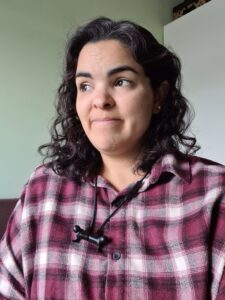Written by Hannah Silvester
I interviewed Mariana Ciocca Alves Passos, member of the executive committee of the Irish Translators’ and Interpreters’ Association (ITIA) about her work on the ITIA executive committee and her role as Irish representative to Audiovisual Translators Europe (AVTE). I found out more about what Mariana is hoping to achieve in these roles, how she got into audiovisual translation, and what she feels academics can do for practitioners.

Can you tell me a bit about your background please?

I was born in Brazil and grew up in São Paolo, which is the biggest city in Brazil. I studied language and literature at the university of São Paolo, and while there I discovered translation. I grew up with TV shows and movies that were dubbed into Portuguese, so I came across translation a lot. I actually started working as a translator before I graduated. Then, in 2010 I moved to Ireland, and when I arrived I continued with this, as well as working as a community interpreter. In 2019, I joined the ITIA – you have to have certain proven experience to be an associate member without a degree in translation, so it took me a while to get to the point where I could prove my professional experience. In September last year, I was invited to join the ITIA executive committee, and that’s where my link with AVTE came from. My language pair is English to Portuguese, and I occasionally did do translations the other way as well, but now I’m working as Brazilian Portuguese Language Lead for ServiceNow, so I’m not doing freelance projects at the moment.
So is your interest to AVT linked to having watched dubbed TV when you were younger?
Yes, and then I came across subtitles when we got cable TV. Hearing the original voices and still being able to understand what they were saying opened up a whole other world for me. My mother was born on the border between Brazil and Argentina so she spoke some Spanish, and was always singing songs and listening to songs in Spanish. She spoke a little bit of Italian too, so languages have always been a part of my life since I was a child. I just didn’t make the connection that I could be the person doing the translations until I went to college. I decided to get into AVT when I was having trouble finding projects that would pay enough in my area, which is mostly localisation. I was trying to find ways to diversify my services and my income. That’s when I decided to take the community interpreting I was offered, and I thought I could try audiovisual translation too. That was around the time when Netflix was recruiting subtitlers through the Hermes test, which nobody in Brazil passed. Indeed, a lot of very experienced subtitlers didn’t pass that test, and neither did I, so I decided to look for some training in subtitling. I did a course on techniques for subtitling through Tradutor Iniciante (Portuguese for ‘beginner translator’) by Laila Compan, and that showed me that subtitling was very different to the skills that I had before. From then, I decided to take on more AVT work.

Can you tell me about the ITIA? What does it do for translators, and why is it good to be part of such an organisation?
As with any professional organisation or association, there is of course a benefit to members, but there is also a sense of belonging that you get from being part of it. Since many of us translators work alone, it can be very lonely, and there’s a sense of belonging in knowing that there are others in the same profession working in Ireland, and even if they aren’t in the same part of the country. The ITIA in Ireland is the only organisation representing the interests of practising translators and interpreters – that is the most important thing. Whether you want to get to know people or improve your working conditions, this is what we are trying to achieve as an association. In terms of the member benefits, there is increased visibility as all members are listed online on the ITIA website. It shows clients that you abide by the ITIA’s code of ethics – it shows commitment to being a professional. As an association, we also offer CPD sessions, so we’re always looking to find out what is of interest to our translators and organise workshops in those areas. The ITIA is also connected to other associations in Europe so our members can sometimes benefit from workshops organised by them too. We try to arrange networking events, as it is very important for professional translators and interpreters to network with colleagues. We depend on each other quite a lot – we can learn from one another and even share work when we are overloaded. After being apart for so long, we are going to try to put together some more in-person networking events. We also just started a mentoring programme this year. We are looking for more mentors who can share the benefit of their experience with colleagues who might need a bit more guidance.
So why is it good? I wasn’t part of an association for a long time, and I think that’s why I felt so isolated. I was working alone and didn’t really know where to go when I needed resources and information, but being part of an association, you know where to go with the questions and you will find someone who knows someone who can help you find the answers.
You can find out more about joining the ITIA, and membership categories here.
Of course, SubCommers are especially interested in AVT, so what is happening in Ireland at the minute in terms of audiovisual translation?
That is part of what I want to find out for AVTE and the ITIA! What’s happening and who is doing what? This will help us to better understand how we can step in and help and support. I know that there is subtitling and dubbing going on for TG4, and RTE has closed captions, AD and Irish Sign Language. In AVTE we see all of these forms of accessibility as audiovisual translation because of the nature of the material that is being translated. Obviously, AVTE is particularly interested in the practitioners – who they are and how we can help and support them. It’s also part of our role to dialogue with other players in the industry, so we want to understand both sides and see how we can best support practitioners.

Why does the ITIA want to connect with AVTE?
The ITIA didn’t have that many members who worked with subtitling or other forms of audiovisual translation, but joining AVTE opened up new possibilities in terms of understanding the challenges and learning from the other associations in terms of how to support our practitioners. I think the biggest thing that comes to mind in that respect for me is the question of intellectual property. That was a new thing for me – AVTE was fighting for subtitlers to be recognised as co-authors or creative workers. I know that in most of the contracts or NDAs that we sign, we give away the rights for our work to the company who are going to use it, and this apparently shouldn’t be in the contract because it’s against European Intellectual Property Rights Law. So having this new connection could help us to see these specific challenges and have this broader representation across Europe where AVT is concerned.
What are your plans as rep to AVTE?
Well, I want to meet people! But first I need to find them. We don’t have many audiovisual translators in the ITIA’s list, so I want to find them and listen to their experiences. I want to understand their work conditions, if they’re happy, where they’re not happy, and what challenges they are facing. Then we can see if we can draw on the wisdom of other organisations to help address these issues and increase visibility, increase rates, all these kinds of things. So I want to learn what the state of things here is, and the best way to find that out is from the AVT professionals in Ireland! I also want to find more people to participate in AVTE’s work, because all members of the ITIA can join their working groups on various issues. And because I am not currently working with AVT, other translators who do will be better placed to contribute to discussions with their experience and knowledge. So, there is my invitation to people who want to join me on this quest!
If you are a subtitler based in Ireland and you haven’t been in touch with us yet, please drop us a line at projectsubcomm@gmail.com and say hi!
Moving on to what Tiina and I are looking to achieve with SubComm, do you have any advice for academics looking to connect with practitioners?
I don’t have any experience of academia with subtitling, but I asked around my colleagues in AVTE, and they said that sometimes connecting is not the hard part, but keeping it going is difficult. So the advice would be to try to think of strategies to keep it going beyond the initial interest and excitement, and try to find ways to keep people engaged. Perhaps using social media, for example. The best way to make yourself known is when other people talk about you and spread the word for you.

Help us spread the word about SubComm through Twitter and LinkedIn!
Is there something you would like to ask of academics?
There is a lot of research, for example, in technology in AVT that doesn’t always align with practitioners’ interests or their goals for improving working conditions and rates. I’m sure it’s not the intention of the researcher to make practitioners’ lives more difficult, but finding topics to research that will involve peoples’ real lives and will positively impact on practitioners’ lives will help in this respect. AVT is a hot topic, but who does the research benefit? If it’s the bigger players then practitioners are less likely to get involved. Addressing questions like the intellectual property issues I mentioned before would certainly help. There are some other aspects like policymaking where researchers could perhaps help us in terms of the rights of audiovisual translators as authors.
This is interesting because this is something that Tiina and I tried to address in our special issue of the Journal of Audiovisual Translation. There is lots of research happening that could benefit practitioners, but those benefits are perhaps not being articulated in a way that speaks to practitioners or through means that are accessible to them. There seems to be a gap where academics are not necessarily articulating what our research can do for you, and this is really an issue on which we all need to work together.
Yes, many practitioners won’t go out and read an academic journal unless they know it is for them.
Yes, we’re trying to work on finding more ways to get academic research out there in a way that can help practitioners! One final question just to finish up. What is your favourite audiovisual translation assignment and why?
I worked on a big project with Khan Academy – that was captioning in Portuguese so that school kids could access the videos in the classroom without the sound on. That was really interesting because I relearned a lot of maths, like equations! But my favourite, favourite one was a very specific medical video that I was doing, it was a presentation of the results of a clinical research trial. I wasn’t very familiar with the topic and the medical terminology so I had to do a lot of research, but what really got me was that none of the speakers were native English speakers, so sometimes it was very challenging to understand the very specific medical language they were using. I think one of the reasons I liked it so much was that when I could manage to figure out what they were saying, it was such a big win, and that was really satisfying!

Mariana and I are really hoping that our work can benefit audiovisual translators in Ireland, and for that, we need to find them. Are you an AV translator working in Ireland? If so, please contact us at projectsubcomm@gmail.com! It was great to hear more on the practitioners’ perspective regarding research in AVT, and Tiina and I will keep cooking up plans to make research accessible, and to continue with our dialogue with industry stakeholders. One part of this could be developing a new channel for communication. Is this something you would like to see, or do you think that the existing forums are enough? Please let us know in the comments, and share your ideas for what format a SubComm forum might take – Facebook Group, Slack, Discord? So many possibilities!
